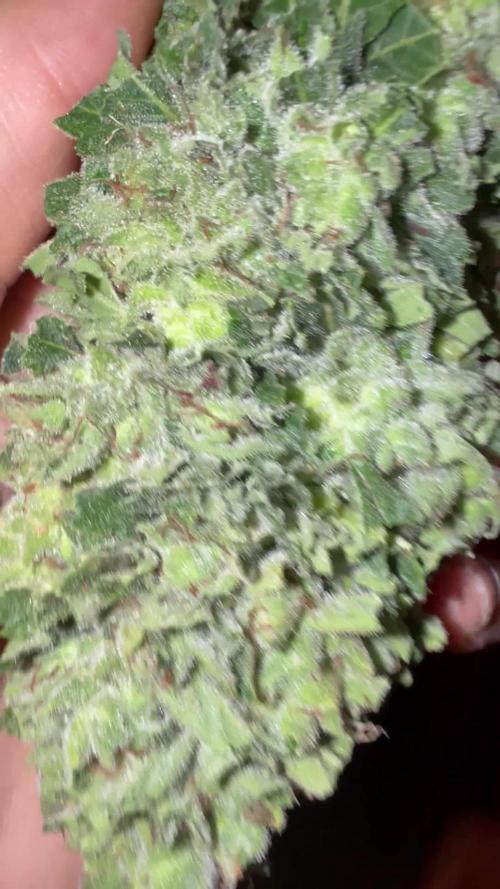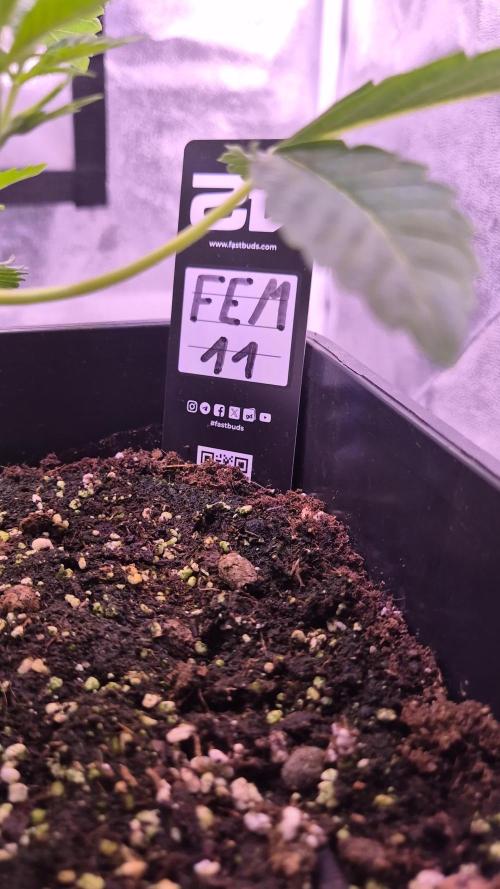The Grow Awards 2026 🏆 























Likes
5
Share


@richsanfarmorganic
Follow
Kk kush by richsanfarmorganic100%
Baby all 80 day
10 Gl : 250++ grams
Natural Organic100%
Mastergrower jahrich420 santipap zongmesa
#naturalfarmsoil & mr.Thcman
Likes
6
Share


@Barcelona_Farmers710
Follow
Esta semana apesar de tener temp Máxima de 28... se va recuperando bien de las podas, el led de TodoGrowled funciona perfectamente para sus 55w farmers!🍯
Likes
22
Share


@MadeInGermany
Follow
Flowering day 18
since time change
to 12 / 12 h
Hey guys :-)
The ladies have recovered well from the cold thanks to the heating mat and have developed beautifully 👍.
During the check today I saw that despite spraying neem oil 3 times, there are still a few trips :-( .
Now I've ordered nematodes again specifically against trips for leaf and substrate.
I will use that immediately 👍.
Watering was done twice this week, each time with 1.3 l (nutrients see table above)
Next week I will remove the lowermost shoots so that the energy goes into the upper buds.
Fresh osmosis water was mixed with tap water and put into the 100 liter tank so that the water can stand and I'll have enough next week :-)
Otherwise everything was cleaned.
Have fun and stay healthy 💚🙏🏻
👇🏼👇🏼👇🏼👇🏼👇🏼👇🏼👇🏼👇🏼👇🏼👇🏼👇🏼👇🏼
A thank you for this wonderful strain goes out to
Herzog
https://instagram.com/herzog030?utm_medium=copy_link
and the Exotic Seeds team
You can buy this Nutrients at :
https://greenbuzzliquids.com/en/shop/
With the discount code: Made_in_Germany you get a discount of 15% on all products from an order value of 100 euros.
You can buy this Strain at :
https://www.exoticseed.eu/
Water: Osmosis water mixed with normal water (24 hours stale that the chlorine evaporates) to 0.2 EC. Add Cal / Mag to 0.4 Ec Ph with Organic Ph - to 5.8 - 6.4
👆🏼👆🏼👆🏼👆🏼👆🏼👆🏼👆🏼👆🏼👆🏼👆🏼👆🏼👆🏼
Likes
14
Share


@Radagast_
Follow
04.08.
Runtz#
Day 64# Day Flowering 47#
The plants are nearing the end, 5 days ago I started to give them a "flawless finish" and if some people needed another 2+ weeks at that point according to what the microscope says, the leaves and the very form of the flowers, but the humidity is high, the rains are frequent lately and the conditions for mold are ideal, so I will not risk it and they are this small, and the caterpillars have also started to be annoying...
However, the situation has changed... half of the plants were almost at full strength, but with the fact that a week ago I gave it overdrive because I planned to give it another two weeks and then give it only clean water for a week or two, it prolonged their flowering, that's what I concluded, a bunch of new transparent trichomes appeared on the flowers and now they need two more weeks at the moment, and I already started with "flawless finish" 4-5 days ago, but well, I'll continue like that when when they are ripe, I pick them unless mold appears or caterpillars attack...
3 or 4 plants will be through a week to a maximum of 10 days ripe (the way I like it) for picking, the rest in two weeks (as I said before, if no caterpillars or mold attack)…
Yesterday was the end of their ninth week.
Rutnz 1# picture no. 29# harvested,trimmed and left to dry on 31.07. it is still drying.
This dwarf had only one big bud along the whole plant, and I expected something like this, especially because it was in grass that is bigger than it, and the humidity has been really high lately... mostly, the mold started and some spiders also ruined it a lot, I must have thrown away a third of the flowers... I had to cut the plant into heads so that I could see all the infected ones and remove them.
Runtz 2# picture no.30# and these two videos
Harvester,trimmed and left to dry 02.08.
This plant also started to mold, the whole two heads that were below, immediately up to the main bud, they started to mold (the empty space between the main head and the lower heads where the stem can be seen), and later, after picking, I inspected the plant in more detail and found something else small all the way down... everything that was even a little bit infected was removed (if a head was slightly infected, the whole head was removed, not just the infected part)
I lost a bit here
less than a quarter of the flowers, approx.
Stay High and Keep Growing!!!
Likes
10
Share


@Grow_Mary_Green
Follow
Hi meine lieben, 🤗
Die 2. Woche der Wachstums-Phase steht an...
...und die realität schlägt zu.
Hatte versucht diesen Run mit einem höheren VPD-Wert und dadurch ohne zusätzliches CalMag hinzufügen zumüssen, laufen zulassen. Da laut einer Studie, man durch einen erhöhten VPD, kein zusätzliches CalMag unter LED's hinzugefügt werden müsste. Allerdings gieße ich noch mit Leitungswasser.
Also hatte ich mir mal die werte meiner Stadtwerke angeschaut. Und in meinem Wasser habe ich Calcium = 78 mg/l und Magnesium = 5,3 mg/l und somit ein verhältnis von 14:1😰. Was von einer Optimalen versorgung von 2:1 - 4:1 CalMag etwas entfernt ist... 😅
Beste Lösung wäre ein Filtersystem wie der Watertrim zu nutzen. Günstiger ist es Mono-Magnesium (oder bei bedarf Mono-Calcium) zu besorgen und das Wasser im richtigen Verhältnis auszugleichen.
_________________________________________________________
Optimale CalMag-Versorgung in den einzelnen Phasen:
Sämling:
Cal: 50-60 mg/l
Mag: 20-30 mg/l
Wachstum:
Cal: 80-100 mg/l
Mag: 30-50mg/l
Blüte:
Cal: 100-120 mg/l
Mag: 40-60mg/l
______________________________________________________________
Wie mein Ablauf in dieser Woche genau aussah, habe ich auch diesmal für uns Dokumentiert. Ich wünsche dir viel Spaß & Happy Growing 🌱🤗:
_______________________________________________________________
Umgebungswerte der Woche:
- Temperatur: 25°C
- Luftfeuchtigkeit: 65%
- VDP (Room): 1,1
_______________________________________________________________
Tag 8:
- Nur beobachtet 😋
Tag 9:
- Pflanzenhöhe gemessen: 17 cm 🌱
- Stamm-Durchmesser gemessen: 0,48cm = 48mm Ø
- Licht Intensität eingestellt - PPFD: 310µmol / DLI: 20 Mol
Tag 10:
Bewässert 👇 (Leitungswasser):
- Volumen: 1000ml
- PH-Wert: 6,15
- EC-Wert: 0,46
- Temperatur: 20°C
Run-Off (Drain) gemessen 👇:
- PH-Wert: 6,5
- EC-Wert: 3,6
- Temperatur: 21°C
- Volumen: 350ml
Tag 11:
- Nur beobachtet 😋
Tag 12:
Bewässert 👇 (Leitungswasser):
- Volumen: 1000ml
- PH-Wert: 6,1
- EC-Wert: 1,52
- Temperatur: 20°C
Run-Off (Drain) gemessen 👇:
- PH-Wert: 6,6
- EC-Wert: 3,1
- Temperatur: ca. 22°C
- Volumen: 280ml
Pflanzen Training: Fimming, Vor-Lollipopping
Lampenabstand eingestellt: 50cm
Licht Intensität eingestellt - PAR - PPFD: 280 µmol / DLI: 18,2 Mol
Pflanzenhöhe gemessen: 20cm 🌱
Tag 13:
- Nur beobachtet 😋
Tag 14:
Bewässert 👇 (Leitungswasser):
- Volumen: 1200ml
- PH-Wert: 6,1
- EC-Wert: 0,48
- Temperatur: 21°C
Run-Off (Drain) gemessen 👇:
- PH-Wert: 6,38
- EC-Wert: 2,5
- Temperatur: 21°C
- Volumen: 360ml
Pflanzenhöhe gemessen: 24 cm 🌱
Stamm-Durchmesser gemessen: 0,70cm = 70mm Ø
Lampenabstand eingestellt: 40 cm
Licht Intensität eingestellt - PPFD: 340µmol / DLI: 22 Mol
Likes
19
Share


@pifflestikkz
Follow
Day 17
17/07/24 Wednesday
De-chlorinated tap water pH 6 with calmag 5ml -5L.
Very humid week, noticed a green turning colour on top of soils where the humidity has been far to high.
I have installed door netting and recently left open all day and night now so they can condition over night in colder temps.
Growth wise, explosive little seed 👌💚
Day 19
19/07/24 Friday
Lite Feed today, 250ml each pot small run off.
Seeing excellent start to these babies. Let's get it 👌💚
Day 21
21/07/24 Sunday
De-chlorinated tap water pH 6 with calmag 5ml to 5L.
Watering in 1L each day from now.
Updated video
Processing
Likes
14
Share


@kevgrow
Follow
Hey Growers, End of week 3 from seed :)
- From the start of the grow Ive been experiencing small issues with plant #2 but everyday I learn new things and try to figure out what she wants and try to adapt to it. looks like its working slowly.
1st time of transplanting, it was a success.
1st week of nutrients, I will feed 1/3 to start
Likes
23
Share


@dataTwiiix
Follow
06/19: Début deuxième semaine de floraison. Elle commence à produire du SUCRE :D. premier fillet mit en place (j33)
Ajout de BudCandy 1/sem (A partir de cette semaine)
06/20: rien à raconter au repos. (J35)
06/21: 2L eau clr (j36)
06/22: (j37)
06/23: à partir de maintenant je vais remplacer 1/2 topMax par boost accelerator de Canna.
06/24: arrosage +/-2L *engraisser
06/25: je ne trouve pas le plants énorme j'aurais du donner plus de grow/fishmix pendant la phase de végétation peu être pourtant j'avais ajouter de l'humus de lombric à mon soil.?¿ (j40)
Likes
60
Share


@m0use
Follow
Nothing to exciting this week, plants are doing well. Little bit of stretching going on and starting to smell more and more now.
The newer growth is a bit lighter in shades of green then the old stuff. I think this is from me dividing the flowering nutrients into 4 weeks vs all at once as they tend to get a bit of N tox when I give it all at once so this seems to be doing better.
Clones are same old, just waiting for the weather to get nice. Found out that when I use Insect Frass as a fertilizer it's also adding in chitin "a protein found in bugs, crustaceans and fungi" to the soil, when that stuff breaks down it makes chitosan and that can help boost defences against pests and virus in the plant. There are plant additives out their that are pure chitosan in varying concentrations and they use this to make the buds extra frosty. To much can harm the plant though. I also found out I needed to water them a bit more then normal not that the stretch is happening. so they got 6L this week each vs the regular 4L but it was split up in 3 days. In the first bit they got all the additives i normally do and the other bit was just PH'd water, didn't want to over load em.
Big shoutout to Medic Grow for sponsoring the lighting in my tent, They have provided me with 2x Mini Sun 2's in the 240w configuration, They use the v1 growing spectrum that is a all purpose seed to harvest spectrum so their is no hassle of switching it mid grow. If you're interested in learning more about Medic Grow products please visit the web link below.
https://medicgrow.com/
https://growdiaries.com/grower/MedicGrowLED
Likes
4
Share


@Weedganja420
Follow
Ha doblado su tamaño esta semana!
Ya se le ven las flores, parece que esta un poco estresada, no creo que sea sobre fertilizacion ya que siempres uso algo menos de fertilizantes de los que recomienda el fabricante.
Ademas intercalo los riegos con agua sola tambien.
Vamos a ir viendo esta etapa de floracion.
Likes
13
Share


@wheedtobeus420
Follow
Day 75 she’s in the dark ice flushing looking beautiful as ever. She smells Devine. I can’t wait for her to finish up so she can get the chop. Her trichomes look so good I can’t even start with her. Beautiful looking lady.
Likes
14
Share


@whitehouse1115
Follow
Did some cleaning up of undergrowth and discovered some weird symptom on the lower growth that was removed. I have done some research but have not found anything. Any help is appreciated. Other than that everything is looking good. Taking longer than I expected but otherwise happy with the way things are going. I believe I am having some circulation issues due to poor design of my rdwc set up. The plant furthest from the reservoir is showing some stress. I am in the process of designing a new setup that will definitely circulate better.






























